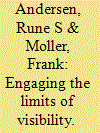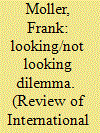|
|
|
Sort Order |
|
|
|
Items / Page
|
|
|
|
|
|
|
| Srl | Item |
| 1 |
ID:
121822


|
|
|
|
|
| Publication |
2013.
|
| Summary/Abstract |
In this article, we introduce selected photographs in order to engage with their capability for questioning the representational codes dominant in the visualization of security policy and surveillance. We argue that the intangible, abstract workings of state power in connection with security, surveillance and current forms of warfare can aptly be represented and challenged by means of photography. By engaging the limits of visibility, the selected photographs explore the limits of photojournalism and security alike. First, they operate by making visible what is normally invisible, though they also blur the boundaries of the seen and the unseen. Second, they function outside the discursive-representational regime within which photojournalism, based on a powerful tradition, operates, and within which media and security professionals visualize security. By so doing, they avoid involuntary incorporation into and support of this very regime that simultaneously they help understand. Third, they visualize structures and institutions rather than people, thus avoiding ethical dilemmas in connection with representations of people in pain. Discussing selected photographs by Trevor Paglen and Simon Norfolk, we show what these photographs do to alter the discursive frame within which the politics of security is understood. Such alteration facilitates understanding of the extent to which current societies are penetrated by the ideas and practices of security and surveillance, and furthers investigation of the discursive structures that enable such penetration.
|
|
|
|
|
|
|
|
|
|
|
|
|
|
|
|
| 2 |
ID:
092443


|
|
|
|
|
| Publication |
2009.
|
| Summary/Abstract |
When confronted with images of war and other forms of human suffering, not looking is not an option, not only because we are permanently exposed to images but also because it would not seem to be a morally tenable position. However, looking at images of human suffering is often said to prolong this very suffering and to fix human subjects as victims. Especially when acts of violence have been committed in order to produce images of these very acts the relationship between viewing the images and participating in the acts of violence qua viewer appears to be uncomfortably close indeed. Thus, looking is not an option, either. This article, in the first part, engages with standard criticisms of photography, especially with accusations according to which photographs aestheticise that which they depict and desensitise their viewers. In the second part it discusses Alfredo Jaar's and Jeff Wall's work in order to show possible ways to circumvent the looking/not looking dilemma.
|
|
|
|
|
|
|
|
|
|
|
|
|
|
|
|
| 3 |
ID:
099981


|
|
|
|
|
| Publication |
2010.
|
| Summary/Abstract |
Engaging with the literature on visual representations of human suffering, being a witness, and trauma, this article discusses visual representations of the 1994 genocide in Rwanda, and especially the art photography of Alfredo Jaar, Robert Lyons, and Jonathan Torgovnik of the aftermath of the genocide. It explores the conditions in which photography can succeed in disrupting stereotypical political interpretations of the killings. Art photography, it is argued, may help transform the viewers from being consuming spectators into being participant witnesses who self-critically reflect upon their own subject positions in relation to the conditions depicted in the image. By discussing photography of the aftermath of the genocide, the article acknowledges the unrepresentability of genocide; by focusing on visual representations, it reflects the extent to which political space is nowadays constituted by means of images; by concentrating on Rwanda, it contributes to the necessary process of examination and self-examination in connection with the killings.
|
|
|
|
|
|
|
|
|
|
|
|
|
|
|
|
|
|
|
|
|